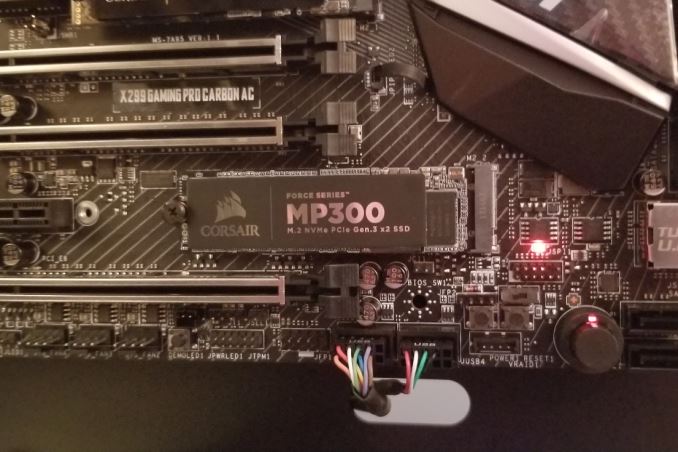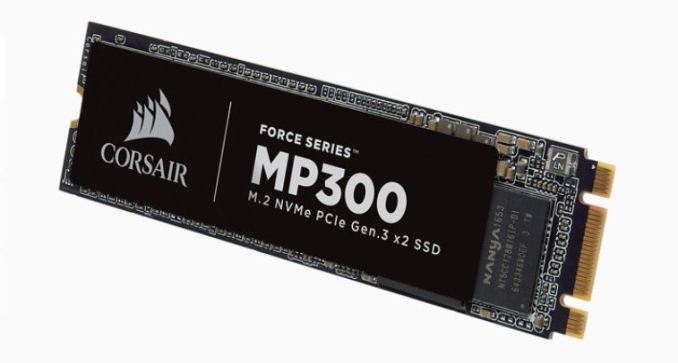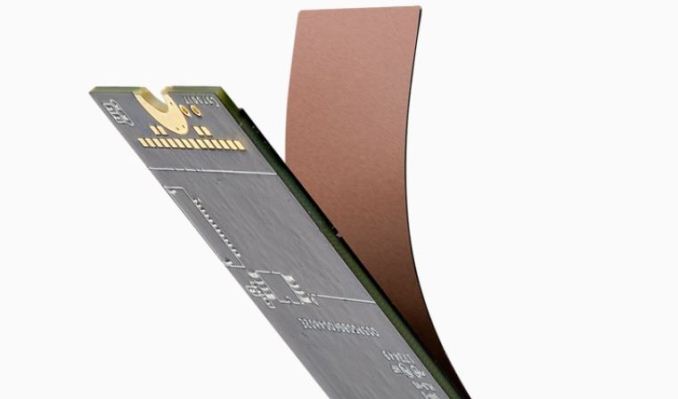Corsair's MP300 Entry-Level Consumer NVMe SSD Starts At Just $49
by Joe Shields on June 7, 2018 1:00 PM EST- Posted in
- Storage
- Corsair
- Trade Shows
- NVMe
- Computex 2018
- MP300

Early on in Computex, Corsair unveiled the new Corsair Force MP300 NVMe 1.3 TB M.2 SSD. Corsair announced the drive during our flight over, so we learned about it at the company's booth where the drive was prominently on display. The Corsair website shows the price ranging from just $49 (120GB) to $320 (960GB).
The drive is up to 3x faster than SATA and designed to help users transition away from the antiquated serial bus that was built for slower media. Specifications for the 3D TLC NAND drives (960GB) are 1600 MB/s sequential read and 1080 MBs sequential writes with IOPS coming in at 240K and 210K respectively. While these are not the fastest NVMe based drives on the market, on paper they are notably faster than the SATA counterparts.
Yet Corsair's approach to the entry-level SSD market comes at a bad time, with pricing pressure coming from all directions. High-quality SATA SSDs like the Samsung 860 EVO 1TB just hit $250 (and even $150 for a few hours) and mainstream NVMe drives like the Adata SX8200 960GB sell for just $350. Corsair will have a difficult time getting this ship off the ground with current pricing for all but the 120GB model, which sells for dinner money at less than $50. At that price, it's hard not to consider the MP300 for a secondary drive used to ease the load on your primary storage by keeping cold data like movies, music, and even games on the MP300.
Corsair backs the new MP300 with a 5-year warranty, the same as the mainstream NVMe MP500. The new series also comes with support for Corsair's SSD Toolbox software and features a copper sticker that spreads the controller heat to aid in keeping the drive cool under intensive workloads.
The drive is available now in all capacities at the Corsair website.
| Corsair Force MP300 NVMe SSDs | |||||
| 120 GB | 240 GB | 480 GB | 960 GB | ||
| Price (MSRP) | $50 | $80 | $150 | $320 | |
| Form Factor | M.2 2280 | ||||
| Interface / Protocal | PCIe 3.0 x2 / NVMe 1.3 | ||||
| NAND Type | 3D TLC | ||||
| Controller | Phison PS5008-E8 | ||||
| Sequential Reads / Writes (MB/s) | 1520 / 460 | 1580 / 920 | 1600 / 1040 | 1600 / 1080 | |
| Random Reads / Writes (IOPS) | 80K / 110K | 110K / 180K | 220K / 200K | 240K / 210K | |
| Warranty | 5-Years | ||||
More information from Computex can be found below.
| Want to keep up to date with all of our Computex 2018 Coverage? | ||||||
 Laptops |
 Hardware |
 Chips |
||||
| Follow AnandTech's breaking news here! | ||||||
Chris Ramsayer contributed to this report.













18 Comments
View All Comments
Amandtec - Thursday, June 7, 2018 - link
If talking PC form factor it is still a big premium over a SATA drive if we are talking a secondary drive.The_Assimilator - Thursday, June 7, 2018 - link
Nobody cares about low-capacity NVMe drives, Corsair.damianrobertjones - Thursday, June 7, 2018 - link
You don't speak for everyone. A business looking to buy a load of these drives will.The_Assimilator - Friday, June 8, 2018 - link
Any business big enough to be bulk-buying computer components already has an OEM like Dell supplying their hardware... and guess what, OEMs don't use mass-market parts like Corsair, they use OEM drives that they buy at OEM discounts.The Chill Blueberry - Thursday, June 7, 2018 - link
Well I do.. at least 240 and above. 120 is a bit on the low side for the "enthusiast product" that is NVMe. But as an add-in for a portable it makes sense.StevoLincolnite - Thursday, June 7, 2018 - link
It's certainly more usable than the antiquated 32GB drives in some Notebooks...damianrobertjones - Thursday, June 7, 2018 - link
Be warned! Now that there's an 'entry level' M.2. it allows the oems to raise the price of the faster drives when no-one is looking.Dragonstongue - Thursday, June 7, 2018 - link
might be "antiquated" but at least a standard sata based SSD is VERY unlikely to suffer throttle issues because of where the drive has to sit and/or per gb are lower costnot to mention most users absolutely do not/can not take advantage of a "proper" m.2 drive potential speed, why pay the extra cost for nothing? (stupid marketing)
also, 9/10 a sata based SSD are pretty much plug and play, m.2/u.2 or whatever are not always as plug and play as they should be, and are not guaranteed to be able to be used as a boot drive (fresh copy of windows) whereas Sata based very rarely this causes a problem.
that being said, pricing for 120-240gb are actually pretty decent the 480gb is "ok" I suppose, the 960gb might be asking a bit much when other makers such as Crucial or Samsung that also offer m.2 drives at higher performance tend to also be lower cost.
IMO they should be trying to keep "even numbers" with a listed GB size available "after format" even if it means they have to add 1 more "chip" to give a higher available drive size...always hated when buy say a 500gb drive and you format it and end up with like 465gb instead AND you still should set some aside for provisioning (be real swell if SSD makers take the desirable amount such as 500gb, add an extra 10% so user is more or less able to load up the drive 100% (as some do)
is like buying a fuel tank that says "can hold 50 gallons" and reality is because of the pump and hoses you can actually only fill it to 45 gallons at best.
Also, while a 5 year warranty is listed, is there any endurance factor to this (such as 280TBW) because if it is 5 year warranty PERIOD that is awesome, but I highly doubt such is the case ^.^
Death666Angel - Thursday, June 7, 2018 - link
Please learn the difference between GB and GiB (and related orders of magnitude) and how Windows uses them. The rest of your post is basically a non-issue. There are more than 100 AM4 motherboards with M.2 PCIe Gen 3.0 x4 slots and over 380 Intel Socket 1151 ones with the same specs. I've just added an NVME module into my H87 chipset BIOS which took me a whole 10 minutes and I can now boot off a NVME in a PCIe adapter connected via gen 2.0 x4 slot. The whole "not plug and play" gets massively overrepresented by people not reading their manuals or the product description when they upgrade. Same thing happens between DDR generational jumps and the switch from AGP/PCI to PCIe and the switch from IDE to SATA. If you don't need the speed and can save some money, great. But you make it seem like it is a bad thing for people to have the option to get a speedier drive? And throttling can be counter acted if it really happens (unless in a tight laptop space). And if it does happen, it is still speedier than any SATA based drive.I've not seen any endurance rating on the Corsair website and prices are a bit high, but they are MSRP and likely to fall. More choice is always good.
Lord of the Bored - Friday, June 8, 2018 - link
"Please learn the difference between GB and GiB" Please don't use Wikipedia's made-up capacity units like they are a real thing.